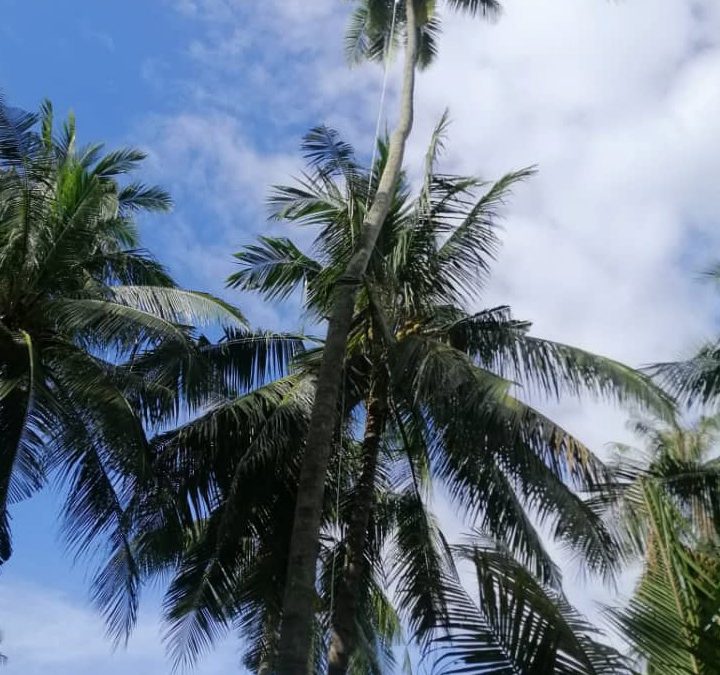Coconut is one of the most significant crops throughout the globe. It is a popular crop and is used for many purposes. The people of more than 80 countries used to produce it. Coconut is mostly harvested at a small -scale by local farmers. Indonesia, the Philippines, India, and Thailand are known as the major coconut-producing countries.
The country of Malaysia is regarded as the 12th largest producer of this crop. Coconut is considered the fourth-largest industrial crop of Malaysia. According to one report, the coconut production capacity of Malaysia is 538,685 in the year 2018 and 504,772 in the year 2016.
The Life Span Of The Coconut Tree:
A gigantic tree of coconut grows from a single seed. The average life span of a coconut tree is from 60 to 100 years. An old coconut tree at Kampung Agong of about 80 years can also be able to produce coconut on it.
A coconut flower takes an entire year to develop into a fruit. The fruits started to grow after 3 to 6.
In this article, Kampung Agong has also compiled a list of the most significant factors and advantages for the cultivation of coconut.
Conditions And Factors Required For Coconut Harvesting:
1. Soil
The coconut can grow in a wide range of soils condition but still, many factors influence its growth. The most suitable soil type includes red sandy loam, laterite soil, alluvial soil, coastal sand, and reclaimed soil.
2. Preparation Of Land
The preparation of land and size of pits depends upon soil type, water table, and the topography of the land. The selected land should have to be clean. In laterite soil, the size of pits should be 1.2m x 1.2m x 1.2 and then fill it with loose soil. In loamy soil, the size of pits should be 1m x 1m x 1m, and then fill it with topsoil.
3. Spacing
Spacing of 7.5 x 7.5 m is most recommendable for tall varieties and can be varied according to the type of land and tree. This space of 7.5 x 7.5 can accommodate around 177 coconut trees per hectare.
4. Planting
Select a one-year-old vigorous seedling with almost 6 leaves and a girth of 10 cm at the collar level. If the area is waterlogged, then 18 to 24-month-old seedling is good to use. Plant the seedling during the pre-monsoon rainy season.
5. Maintenance And Care
After plantation, regular manuring is extremely essential for the proper growth of the plant. Use 30kg organic manure per tree every year. You can use any form of organic manure such as compost, farmyard manure, bone meal, fish meal, neem cake, etc.
6. Intercultural Operations
Digging, ploughing, mounds forming takes place between august- September and spread in December -January. Regular inter-cultivation is also essential thing n order to keep the weeds under control except for sandy soil.
7. Cropping System
Intercrops / mixed crops are used to maximize the utilization of necessary factors such as soil and sunlight. You can use cereal crops, legumes, and pulses, spices, fruit plants, etc. Select the crop by considering its growing season and other factors.
The following crops can be used for intercrop in the coconut garden:
– Pineapple, banana, elephant foot yam, groundnut, chillies, sweet potato, tapioca is used for up to 10 years old tree.
– During the age between 10 -20, you can cultivate colocasia.
– Use perennials crops for the older plantation.
8. Harvesting
Coconut is harvested at varying internal in one year. A high-yielding garden is harvested once a month. The mature coconut becomes ready in about 12 months and can be used for making coconut products.
Advantages Of Coconut:
Coconut is a popular worldwide crop that is used for multiple purposes and holds numerous advantages. Some of the common advantages of coconut are as follows:
– Coconut oil holds unlimited health benefits, medicinal uses, and nutritional value. People used to apply it externally and also consume it.
– Coconut water is used widely as a refreshing drink and also used for other purposes. It is also a source of various minerals and nutrients.
– Many industries are using coconut roots to make dyes, toothbrushes, and many other products.
– The coconut husk and shell are used for buffing floors, fuel, and charcoal. People used it as a handicraft and make toys and other stuff from it.
– The leaves of the coconut are being used as roofing material in the Maldives. It is also used for making toothpicks and satay skewers.

